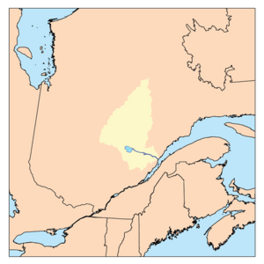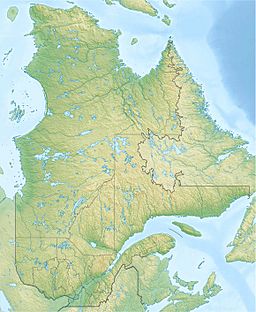Vimont Lake facts for kids
Quick facts for kids Vimont Lake |
|
|---|---|

Watershed of Saguenay River
|
|
| Location | Eeyou Istchee Baie-James (municipality) (RCM) |
| Coordinates | 49°42′09″N 73°55′41″W / 49.70250°N 73.92806°W |
| Type | Natural |
| Primary inflows |
|
| Primary outflows | Outlet of Vimont Lake, flowing to Boisvert River (Normandin River). |
| Basin countries | Canada |
| Max. length | 9.4 kilometres (5.8 mi) |
| Max. width | 3.7 kilometres (2.3 mi) |
| Surface area | 12.12 kilometres (7.53 mi) |
| Surface elevation | 413 metres (1,355 ft) |
Vimont Lake is a beautiful freshwater lake in Quebec, Canada. It's located in the northwestern part of the Le Domaine-du-Roy area. The lake is mostly within a region called the Vimont canton.
People use the area around the lake for two main things. The most important is forestry, which means cutting down trees for wood. The second is recreational tourism, like visiting for fun activities.
Getting to Vimont Lake is quite easy. There's a forest road on the east side. Another road, R0210, runs along the west side. This road connects to Route 167, which goes from Chibougamau to Saint-Félicien, Quebec. The Canadian National Railway also runs near this road.
The lake usually freezes over in early November. It stays frozen until mid-May. You can safely walk or play on the ice from mid-November to mid-April.
Contents
Exploring Vimont Lake: Size and Location
Vimont Lake is quite large! It stretches for about 9.4 kilometres (5.8 mi) (almost 6 miles) long. At its widest point, it measures 3.7 kilometres (2.3 mi) (about 2.3 miles) across. The lake sits at an elevation of 413 metres (1,355 ft) (about 1,355 feet) above sea level. In the southern part of the lake, you'll find a group of small islands.
Where Does Vimont Lake Water Go?
The water from Vimont Lake flows out from its mouth. This outlet is 5.3 kilometres (3.3 mi) east of where the water leaves the lake. The water then travels to the Boisvert River.
Vimont Lake is part of a big network of rivers and lakes. Here's how far it is from some other important water bodies:
- 22.7 kilometres (14.1 mi) northeast of the mouth of Boisvert Lake (Normandin River).
- 39.9 kilometres (24.8 mi) north of Nicabau Lake, which the Normandin River flows through.
- 56.1 kilometres (34.9 mi) northwest of the mouth of the Normandin River.
- 165 kilometres (103 mi) northwest of the mouth of the Ashuapmushuan River.
- 199 kilometres (124 mi) northwest of the mouth of Lac Saint-Jean.
Rivers and Lakes Near Vimont Lake
Many rivers and lakes are connected to Vimont Lake. They form a large water system.
- To the North: Boisvert River, Hogan River, Waconichi Lake, Mistassini Lake.
- To the East: Barthelemy Lake, Dobleau River, Chief River, Nestaocano River, Ashuapmushuan River.
- To the South: Chaudière River, Lac de l'Aventure, Chaudière Lake, Atouk Creek, Normandin River, Aigremont Lake.
- To the West: Boisvert River, Armitage River, Chibougamau Lake, Énard River.
The Journey of Vimont Lake's Water
The water from Vimont Lake flows out into a bay on its western side. From there, it travels west to Rubens Lake. The water crosses Rubens Lake for 1.9 kilometres (1.2 mi) to the north.
After Rubens Lake, the water flows for 7.8 kilometres (4.8 mi). It first goes southwest, then west, until it reaches Pulley Lake. The Boisvert River flows through Pulley Lake.
From Pulley Lake, the water continues its journey for 41.9 kilometres (26.0 mi). It flows west, then south, until it reaches Charron Lake (Normandin River). The water crosses Charron Lake for 4.3 kilometres (2.7 mi) to its outlet, which is near Route 167.
From this road bridge, the water flows through "Lac la Blanche" for 7.4 kilometres (4.6 mi). Then it goes through Jordan Lake for 9.8 kilometres (6.1 mi). Finally, it reaches Nicabau Lake and flows through it for 9.7 kilometres (6.0 mi) to a dam.
From the dam, the water flows southeast along the Normandin River for 38.7 kilometres (24.0 mi). It ends up in the northwestern part of Ashuapmushuan Lake. After that, the water flows through the Ashuapmushuan River, which eventually reaches Saint-Félicien, Quebec on the west side of Lac Saint-Jean.
The Name of Vimont Lake
The name "Lac Vimont" comes from the name of the area, or "township," called Vimont.
This name honors a special person: a Jesuit priest named Barthélemy Vimont. He was born in France in 1594. He first came to New France (what is now Canada) in 1629. He worked as a chaplain near Cape Breton Island.
Father Vimont had to go back to France for a while. He returned to Quebec on August 1, 1639. He was a very important leader for the Jesuits from 1639 to 1645. He even saw the founding of Montreal by Paul Chomedey de Maisonneuve in 1642.
After another trip to France, he came back to Quebec in 1648. He continued his work there and in nearby areas until 1659. He then left New France for France, where he passed away eight years later in 1667.
The name "Lac Vimont" was officially recognized on December 5, 1968, by the Commission de toponymie du Québec, which is like the official naming board for places in Quebec.


